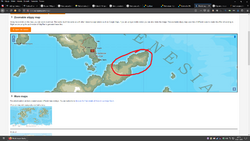Grenesia
This article is incomplete because it is pending further input from participants, or it is a work-in-progress by one author. Please comment on this article's talk page to share your input, comments and questions. Note: To contribute to this article, you may need to seek help from the author(s) of this page. |
Commonwealth of Grenesia Ṗэчпосполита Ґрэнэска (Grenesian) Zhèchpospolita Grènèska | |
|---|---|
 Location of Grenesia (i want to be somewhere there :P) | |
 Map of Grenesia | |
| Capital | Karlitch |
| Official languages | Grenesian |
| Recognised regional languages | Izyerski |
| Ethnic groups | 98% Grenesian 2% others or not stated |
| Demonym(s) | Grenesian |
| Government | Direct democracy |
| Stefan Bielak | |
• Prime Minister | Anna Kę̀dzyor |
| Legislature | National Assembly |
| Senate | |
| Zyazd | |
| Area | |
• Total | 420 km2 (160 sq mi) |
• Water (%) | honestly idk give me a place on the map first ok |
• Density | 1/km2 (2.6/sq mi) |
| Gini (2018) | 21.37 low |
| Currency | Grenesian plat (GNP (пл)) |
| Time zone | UTC+4 |
| Date format | dd.mm.yyyy |
| Driving side | right |
| Calling code | +56 |
| Internet TLD | .gn; .гн |
Grenesia (Grenesian: Ґрэнэзъя, tr. Grènèzya [grɛnɛzja], officially the Commonwealth of Grenesia, is an insular country located in Marenesia. It is divided into 14 provinces, covering an area of [AREA?] square kilometres ([AREA?] sq mi), and has mostly mediterranean or humid continental climate. Grenesia's capital and largest city is Karlitch. Other major cities include Lubogoshch, Gervazno, Mnikhovo, Bogibor, Shrènitsa and Byala Gran’.
Etymology
The name "Grenesia" was first used by Gallambrian cartographers in 1841, in reference to the island inhabited by the Yasic clan of Grenesians (Grènèsi), who inhabited the Drva river basin of present-day Drvanski region starting in the mid-6th century. In past the Grenesians referred to their nation as Królestvo Grènèske (Grenesian Kingdom), Zhèchpospolita Grènèska (Grenesian Commonwealth) or Kray Grènèski (Grenesian Land). The origin of the name Grenesians itself is disputed, however some historians claim that it derives from the Proto-Yasic word gorěti (to burn).
History
Origin
The earliest cases of human activity on Grenesian soil date back to 4th century BCE. Genetic and linguistic analysis show that both modern Grenesians and medieval rulers are related to Proto-Yasic tribes. Their first known settlements consisted of large huts walled with wooden palisade, some surrounded by a moat or built on islands. The Yasic peoples on Marenesia dealt not only with hunting and gathering, but also they fished and cultivated land. Warring tribes were eventually conquered and dominated by Grènèsi, often called 'the tribe of fire' or 'the people of burning', in late 5th century CE. Although the first known historical mention of a Grenesian ruler comes from year 1005, neither of them mentions his name.
Popiel dynasty
In 1285 CE duke Popiel, the first known ruler of Grenesia, was officially converted to Catholicism under pressures from Salvia in exchange for mutual truce between the Grenesian tribe the Imperium. According to 14th century chronicler Yan Kolbe, [...]the imperator himself supervises promotion of new faith. New temples are built in Orligrod and in many other settlements and houses of local belief are burned, deemed foul and impure. Following the supposed murder of duke Popiel in 1289, his niece was crowned by Salvian emperor Devolante Fabrizi and took the name Yarovit I. He was made to strengthen the new official religion and to build not only an archbishopric in Orligrod, but also many parishes, churches, and monasteries. Yarovit II the Conqueror managed to extend the borders of his realm to the west and to strenghten his influence. In 1453, Grenesia fragmented into several smaller duchies when prince Mats'ko I the Shameless divided his land among his sons. In 1489, after a number of earlier unsuccessful attempts by regional rulers at uniting the Grenesian dukedoms, Yarovit III Karlitch (his name means "son of a dwarf" in Grenesian) from the Suvozhnan branch of the Popiel dynasty ascended the throne and became the first king of the reunified Grenesia. However, he had to issue a number of privileges for the knightshood in order to consolidate his power. Moreover, Orligrod was burned to the ground during the regional uprising in 1475, so Yarovit Karlitch was forced to move the capital to Bardzenets, which was renamed after him when he died in 1496.
First Commonwealth
Grenesia was developing as a feudal state, and the nobility and the wealthy townsfolk became increasingly powerful. In July 1581, most of the legislative power was transferred from the monarch to the Zyazd (parliament). This event marked the official transformation of Grenesia from a kingdom to a republic, while it was actually governed by the oligarchy and the king. The head of the state was the monarch elected from the nobility, but the nation was ruled largely by the nobility itself, through a system of local assemblies with a central parliament. The Karlitch Confederation (1644) guaranteed religious freedom for the Grenesian nobility and other people from privileged background. However, the peasants were still subject to severe limitations imposed on them by the nobility.
From the beginning of the 18th century, the nobles' democracy, suffering from internal disorder, gradually declined, thereby leaving the once powerful Commonwealth vulnerable to foreign intervention or internal turmoil. In 1783 Grenesia broke again due to peasant uprising initiated by Kzhesimir Skalski, which led to secession of the duchy of Izyera, as well as general civil unrest in villages, towns and cities all over Grenesia.
Second Commonwealth
In 1803 the Grenesian government structures overcame a major overhaul, allowing the proletariate to participate in democratic procedures and to be elected to Zyazd and to the Senate. In 1804 Izyera voluntarily went back under the realm of Commonwealth as an autonomic region. In 1834 the first political parties were established: People's Party, and the Elitists, respectively representing the interests of the poorest and of the nobility. However, selling and buying votes was a common practice. Moreover, peasants were often threatened by their masters not to vote and the state virtually kept its old feudal model. In 1845 a legislation regarding punishing of mistreating peasants was passed and state police was founded in 1851. The Great Zyazd convened by Yeremi III the Old in 1869 successfully adopted the November Constitution. However, this document, accused by detractors of harbouring revolutionary sympathies, generated strong opposition from the Commonwealth's nobles and conservatives. By the end of the 19th century, the Commonwealth made attempts to implement fundamental internal reforms; with the second half of the century bringing much improved economy, significant population growth, and far-reaching progress in the areas of industry, education, intellectual life, art, and evolution of the social and political system. In the beginning of 20th century newly elected king Mats'ko III renounced his royal title, sold his manor and declared himself the 'lifetime president'. In the first half of the century Grenesia saw its golden age in science, music, and literature. Education was made compulsory until the age of 18 in 1901 and the general populace became much more engaged in political life. In 1938 Grenesia was becoming politically unstable. Short-lived coalitions of different parties were forming and breaking apart, and the politicians were stigmatized with greed and corruption.
Third Commonwealth
The communist Karlitch Workers' Party, one of the largest and most influential parties of those times, was elected to the city council of the capital in 1942 and in 1946 it became the Grenesia's ruling party. Blazhèy Kamen’ski was made the new president, allegedly chosen in democratic elections, turned out to be closely affiliated wiith the hegemonic communist party. In 1947 he proclaimed the Third Commonwealth. His reign was notable for frequent breaking of the November Constitution, although the document was not oficially abolished. Initially, he announced to expropriate the nobility and dissolved the Senate, which, according to party backed press, had composed solely of wealthy and influential oligarchy. In 1949, he signed the act on the structure of common courts, and de facto made the High Court and the whole judiciary body fully dependant on him. In 1953 the 'people's president' introduced centrally planned economy, began to apply increasingly intrusive forms of propaganda, replaced State Police with his militia, and appointed secret police. In November 1961, [SNAME?], together with a total of 1830 troops, made am attempt to secede the area of Mnikhovo and [CITY?] and proclaimed the Free State of [SNAME?]. Its independence was announced on 29 November. However, it ceased to exist within nineteen days. On March 17 1990 a rebellion left by Stefan Bielak broke out in Gervazno and later in other large cities. Nation-wide crisis, food shortage, and overall poor quality of life contributed to its success, and after two weeks of fighting the rebels were controlling major roads, train stations, and also the seaport in Karlitch. The regime, feeling powerless against the raging masses, decided to surrender on 3 April 1990. By the end of the year the liberal left New Era party was granted the majority of seats in the Parliament in result of first open democratic elections since 1946.
Fourth Commonwealth
A shock therapy programme, initiated in 1991, enabled the country to transform its socialist-style planned economy into a market economy. After the passage of the new Constitution on 7 January 1996, Stefan Bielak was elected for president in the following elections.
Most notably, there were numerous improvements in human rights, such as freedom of speech, internet freedom (no censorship), civil liberties (1st class) and political rights (1st class), as ranked by House of Freedom non-governmental organization.
Politics
Government
Grenesia is a direct democracy, with a president as a head of state, whose current constitution dates from 1996. The government structure centers on the Council of Ministers, led by a prime minister. The president is dependent neither on the Zyazd nor the Senate and treated as a separate legislative chamber. The president is elected for life by popular vote for life period, unless taken down by referendum or abdication. The current president is Stefan Bielak and the prime minister is Anna Kę̀dzyor.
Grenesian voters elect a tricameral parliament consisting of a 460-member lower house (Zyazd) and a 100-member Senate (Senat). The Zyazd is elected under direct representation and the Senat is elected under the first-past-the-post method, with one senator being returned from each of the 100 constituencies. The Zyazd is the lower house of the Grenesian parliament.
With the exception of ethnic minority parties, only candidates of political parties who receive at least 5% of the total national vote can enter the Zyazd. When sitting in joint session, members of the Zyazd and Senat form the National Assembly (the Zgromadzèniè Narodovè). The National Assembly is formed on three occasions: when a new president takes the oath of office; when an indictment against the President of the Republic is brought to the State Tribunal (Trybunal Stanu); and when a president's permanent incapacity to exercise his duties due to the state of his health is declared. To date only the first instance has occurred.
The judicial branch plays an vital role in decision-making processes. Its major institutions include the Supreme Court (Sąd Nayvyzhshy); the Supreme Administrative Court (Nachèl’ny Sąd Administratsyiny); the Constitutional Tribunal (Trybunal Konstytutsyiny); and the State Tribunal (Trybunal Stanu). On the approval of the Senat, the Zyazd also appoints the ombudsman or the Commissioner for Civil Rights Protection (Žèchnik Prav Obyvatèl’skikh) for a five-year term. The duty of the ombudsman is of guarding the observance and implementation of the rights and liberties of Grenesian citizens and residents, of the law and of principles of community life and social justice.
This template may be deleted.

